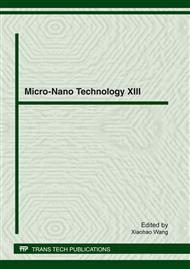p.179
p.183
p.188
p.194
p.201
p.207
p.211
p.216
p.222
Air Gap Flux Density for the Planar Motor
Abstract:
An analytical method was presented to predict the three-dimensional (3-D) magnetic flux density distribution in the air gap produced by NdFeB permanent magnets of the planar motor. First, the analytical model of the planar motor was established, and Laplace equations of magnetic scalar potential and a series of boundary conditions were given. Then, the analytical expressions of magnet field strength and magnet flux density were obtained in the air gap of produced by NdFeB permanent magnets by the method of separation of variables. Finally, Comparisons the analytical results and finite element results, and the error never exceed five percent. Therefore, high precision has been derived. The analytical field results provide a basis for comparative studies, design optimization, and machine dynamic modelling of the planar motor.
Info:
Periodical:
Pages:
201-206
Citation:
Online since:
February 2012
Authors:
Keywords:
Price:
Сopyright:
© 2012 Trans Tech Publications Ltd. All Rights Reserved
Share:
Citation:


